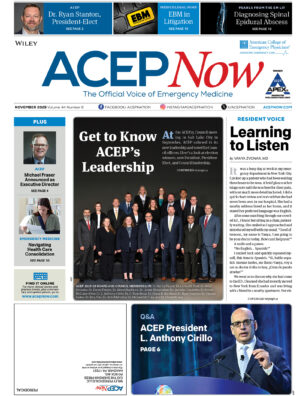Editor’s Note: Read Dr. Cedric Dark’s commentary on this EMRA + PolicyRx Health Policy Journal Club article.
Explore This Issue
ACEP Now: Vol 38 – No 07 – July 2019The meteoric rise in health care costs in the United States is in part attributed to the rise in emergency department visits for primary care–treatable illness and other low-acuity visits. These visits place additional strain on emergency departments already overcrowded from boarding admitted patients and places a burden on emergency physicians to function with fewer rooms, fewer support staff, and fewer resources. As a result, quality of care suffers; costs and wait times increase, corresponding to decreases in patient and provider satisfaction.
To date, interventions attempting to reduce ED utilization have utilized non-physicians (care managers and nurses) to provide generic nonmedical information about alternative care options; they have had variable success. A new study—a multi-facility, randomized control trial—aimed to evaluate the impact of a brief educational phone call by an emergency physician and/or mailed information following an ED visit on subsequent six-month ED utilization rates in low-acuity adult patients.1
The study found statistically significant decreases in ED use by 22 percent among patients over 65 years of age who received follow-up phone calls and by 27 percent among patients under 65 years of age receiving a follow-up mailing.
Targeted educational interventions have had varying effectiveness as they are subject to a variety of barriers including the complex interplay of geographic, cultural, and socioeconomic factors. Another important limiting factor of any communication is the receiver. They may be variably receptive to the information provided or may variably change their behavior. Although adherence to treatment care plans is far from optimal in health care, patients still want to hear mostly from their physician.
This same group of researchers conducted another study that found significant reductions in future ED utilization when emergency physicians made post-visit phone calls. However, no change occurred when emergency nurses made similar contact, suggesting that patients were perhaps more receptive to receiving information from emergency physicians.
While “decompressing” certain aspects of health care like ED utilization, this intervention could also potentially place increasing stress and demands on emergency physicians to make these follow-up calls. Who pays for the physician’s time? Isn’t increasing the demands on emergency physicians, asking them to do more and more with less and in less time, what’s already causing toxic stress in the health care system in the first place?
Dr. Ravichandran is a pediatric emergency medicine fellow at the Children’s Hospital of Michigan in Detroit
Reference
- Patel PB, Vinson DR, Gardner MN, et al. Impact of emergency physician-provided patient education about alternative care venues. Am J Manag Care. 2018;24(5):225-231.
Pages: 1 2 | Multi-Page




No Responses to “New Study Says Calls and Letters from Physicians Cut Future Emergency Department Visits”